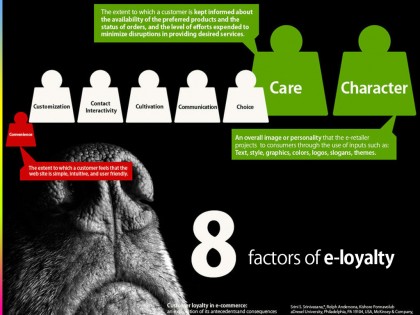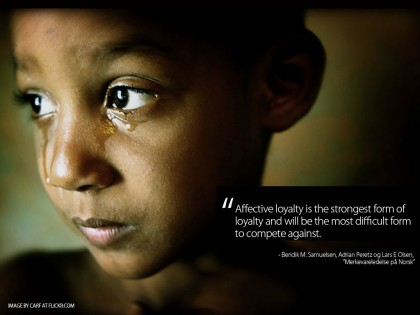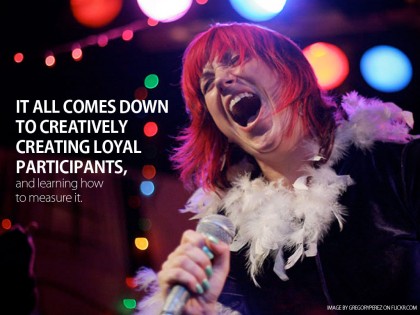Because of the financial down turn 2009 is looking to be the year of the short-term strategies. This is very understandable in a top-of-mind strategic thinkers world. But we don’t need top-of-mind, what we need is creativity; in planning, mechanics and execution.
This is the second of two posts on Brand Building in 2009. The first one was about strategic creativity, you can find it here. In this post I will focus on another important character: Loyalty.
The reason is simple: You want to sell more products and services for less, the best way to do this is continue talking and selling to existing customers
. Gaining their loyalty is key.
But why is loyalty so important, and what is it?
According to the study “Customer Loyalty in e-Commerce” from Drexel and McKinsey the most important aspects of e-loyalty is trust and personality. It’s not low prices, usability or a coupon. No, it’s a brands that they can count on, that helps them feel secure and informed. That goes out of its way to offer extra service. And it’s a brand with an identifiable and unique personality one can relate to.
Combine this with this extract on loyalty from the book “Brand Leadership in Norwegian” by Samuelsen, Peretz and Olsen:
There are three kinds of loyalty:
- – Action Based Loyalty. This is measuring the activity of repeat purchase. But! Action Based Loyalty has got little to do with loyalty, because it is only concerned with the action itself, not the drivers or incentives behind it. As Lou Carbone has said “Just because I fly AIRLINE doesn’t mean I love them, I hate AIRLINE”. This is unfortunately the loyalty most often tracked and used as a success metrics by brands.
– Rational loyalty. A much used technique where price, accessibility or other rational characteristics are used to create repeat purchase. An example from Norway is a retail store lowering their prices on fruits and vegetables by 20%. Very effective. But the weakness of Rational Based Loyalty is that it doesn’t stick, it is very unfaithful. You have it only as long as you are the best in the category where you aim to build your loyalty. As soon as you stop investing in it, or someone delivers an improved service, the loyalty shifts.
– Affective Loyalty. This is the loyalty created by an emotional brand. By building an idea, a story around the brand and communicating this in a way that the customers finds relevant and want to engage with – in order to become participants. Affective Loyalty sticks, it lasts longer than any other form of loyalty, and it creates a unique position the brand can establish an ownership of:
“Affective loyalty is the strongest form of loyalty and will be the most difficult form to compete against.” – Brand Building in Norwegian, Samuelsen, Peretz and Olsen
This means that even though loyalty might not be as direct response as other tools, done correctly it will be one of the most effective measures you can undertake – directly affecting your bottom line by creating loyal participants who will start preferring your products
significant benefit in select patients but this should beflow into the lacuna spaces (sponge-like penile tissue). viagra pills.
.
2009, the year of the loyal customers.
Because brands are the one thing we have that gives us an advantage. If it is an excellent product or impeccable stories – I don’t care – but being able to tell it to people, in your way, in your personality, that is trés importante.
Again, we need to fill the holes in the bucket, not pour new water in from the top. I believe 2009 will be all about retaining your existing customers and investing in the right kind of loyalty through new tools. Because we shouldn’t spend our way out of recession, but we shouldn’t dig ourselves into a trench we can’t get out of either.
It all comes down to creatively creating loyal participants, and learning how to measure it.






I agree with you on the types of loyalty. Coupons etc is bought loyalty. But not spending ourselves out of a recession, I don’t know. Nobody ever went on a diet to get out of starvation (translation doesn’t work, but you get it). Anyways; loyalty can be about brands understanding that they don’t live in a vacuum (the other way around – brand to customer). Times are the way they are, and value for money and more for less is what many people would like (I read the top U.S trend; value for money in everything). It’s an interesting thought that brands with “high” affective loyalty, can bring some rational loyalty to those people and “be on their side” in hard times. Much better than brands that don’t enjoy the hard earned affective loyalty. I think.
Hi O.S thank you for commenting.
I think we do agree on the spending part, I just can’t see that spending yourself out of it is a solution in and of itself. (as it sometimes is presented: “what to do? Increase marketing”).
I mean, as you point out, that value for money is the way to go, and exploring new and different techniques to achieve your goal – might be the way to go. It’s the direction I believe in :o)